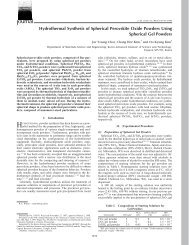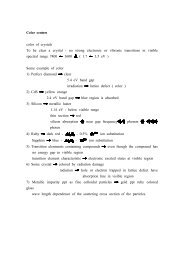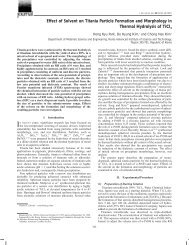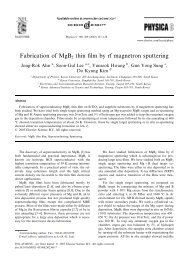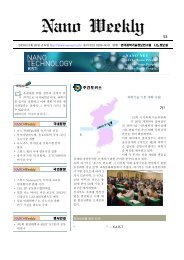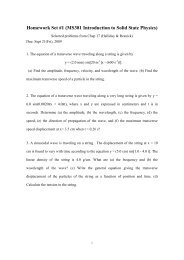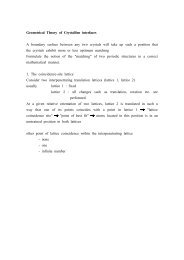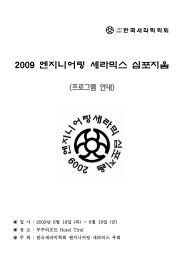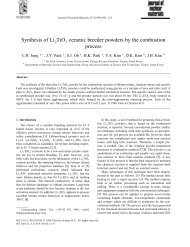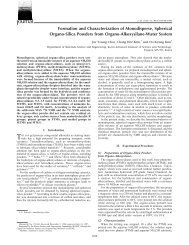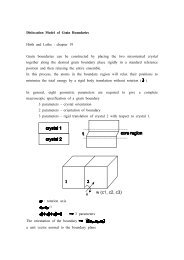Spinel LiMn2O4 Nanorods as Lithium Ion Battery Cathodes
Spinel LiMn2O4 Nanorods as Lithium Ion Battery Cathodes
Spinel LiMn2O4 Nanorods as Lithium Ion Battery Cathodes
You also want an ePaper? Increase the reach of your titles
YUMPU automatically turns print PDFs into web optimized ePapers that Google loves.
Figure 2. (a) XRD pattern, (b) SEM images, (c) low- and highresolution<br />
TEM of <strong>LiMn2O4</strong> nanorods <strong>as</strong> obtained from solid-state<br />
reaction between -MnO2 nanorods and LiOH·H2O.<br />
Figure 3. (a) Galvanostatic (0.1 C) first charge/discharge curve,<br />
(b) potentiostatic differential capacity vs voltage (dO/dV), (c)<br />
discharge specific capacity curve vs number of cycles for nanorods<br />
(black dots) and commercial powder electrode (white squares) at<br />
different power rates, and (d) charge (white) and discharge (red)<br />
specific capacity curve vs number of cycles for nanorod electrode<br />
at 1C rate.<br />
(Figure 3b). Moreover very good energy efficiency is<br />
observed. In fact, the potential drop between the charge and<br />
the discharge process is only 40 mV at the rate of 28.6 mA/<br />
g, indicating the f<strong>as</strong>t kinetics of the system. Since we are<br />
interested in evaluating the material <strong>as</strong> the cathode in the<br />
Li-ion battery, we used a discharge cutoff value of 3.5 V,<br />
which is similar to the requirement for commercial application.<br />
At the end of the first discharge the charge excess is<br />
lost (Coulombic efficiency of 90%). We have to consider,<br />
however, that usually a battery pack is <strong>as</strong>sembled with a<br />
certain amount of extra capacity at the cathode to compensate<br />
irreversible anode reactions taking place during the first cycle<br />
(solid electrolyte interph<strong>as</strong>e (SEI) formation, surface oxide<br />
reduction, etc.). In this c<strong>as</strong>e, it is an advantage to use the<br />
charge excess instead of loading more material at the cathode.<br />
The voltage versus dQ/dV curve clearly points out the<br />
different nature of the two processes at high potential (Figure<br />
3b). The former one, at potential ranging from 3.9 to 4.1 V,<br />
displays a bell shape peak at 4.05 V which h<strong>as</strong> full width at<br />
half-maximum (FWHM) of 55 mV while the latter process<br />
shows a spike peak at 4.15 V with just 5 mV in FWHM.<br />
The sharp peak observed in this latter peak (Figure 3b)<br />
corresponds to a flat plateau in Figure 3a, a clear indication<br />
of the coexistence of two ph<strong>as</strong>es. The difference between<br />
the two processes is also evident during the discharge scan<br />
in which they occur at potentials of 4.10 and 3.95 V with<br />
FWHM of 10 and 50 mV, respectively.<br />
The discharge specific capacity of the nanorods <strong>as</strong> a<br />
function of cycle number h<strong>as</strong> been compared with the<br />
result obtained using an electrode obtained from commercial<br />
powders (<strong>LiMn2O4</strong> electrochemical grade, Sigma<br />
Aldrich) using the same preparation route (Figure 3c), that<br />
is, the commercial electrode is a mixture of active material,<br />
carbon black, and binder in the weight ratio of 85:10:5. The<br />
charge capacity is me<strong>as</strong>ured with the power rate from 0.1 C<br />
(14.8 mA/g) to 1 C (148 mA/g). We have observed that the<br />
nanorod morphology h<strong>as</strong> a much higher charge capacity than<br />
the commercial powders at higher power rates. At the lowest<br />
current (from cycle 1 to 5) both the samples have a specific<br />
capacity around 110 mAh/g but incre<strong>as</strong>ing the rate to 0.2 C<br />
(from cycle 6 to 10) leads a large difference in performance:<br />
the specific capacity of the nanorod electrode remains almost<br />
constant between 110 and 105 mAh/g while that of commercial<br />
powder decre<strong>as</strong>es to 70 mAh/g. In most of the<br />
literature a larger amount of conductive agent (up to 20%)<br />
is added to the active <strong>LiMn2O4</strong> material and the specific<br />
discharge capacity obtained at moderate rates such <strong>as</strong> 0.2 C<br />
is comparable to that of our nanorods. However, we point<br />
out that in our nanorod c<strong>as</strong>e, reducing the amount of carbon<br />
black (10 wt %) and incre<strong>as</strong>ing the active material ratio<br />
means that more charges can be stored in the electrode<br />
regardless of the obtained <strong>LiMn2O4</strong> specific capacity. This<br />
advantage results from the one-dimensional electron transport<br />
and large surface area of the nanorods. The difference of<br />
specific charge capacity between the nanorods and commercial<br />
powders becomes larger with the further rate incre<strong>as</strong>e<br />
(Figure 3c). At the highest current (148 mA/g), the nanostructured<br />
electrode can deliver a specific charge capacity<br />
(100 mAh/g) twice of the commercial powders (50 mAh/g).<br />
These data indicate that the large surface-to-volume ratio of<br />
the nanorods enhances greatly the kinetics of the <strong>LiMn2O4</strong><br />
3950 Nano Lett., Vol. 8, No. 11, 2008



